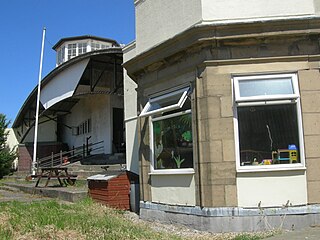
The de Havilland DH.89 Dragon Rapide is a 1930s short-haul biplane airliner developed and produced by British aircraft company de Havilland. Capable of accommodating 6–8 passengers, it proved an economical and durable craft, despite its outdated plywood construction.

British Airways Ltd was a British airline company operating in Europe in the period 1935–1939. It was formed in 1935 by the merger of Spartan Air Lines Ltd, United Airways Ltd, and Hillman's Airways. Its corporate emblem was a winged lion.

Isle of Man Airport is the main civilian airport on the Isle of Man. It is located in the south of the island at Ronaldsway near Castletown, 6 nautical miles southwest of Douglas, the island's capital. Along with the Isle of Man Sea Terminal, it is one of the two main gateways to the island. The airport has scheduled services to the United Kingdom and the Republic of Ireland.

The de Havilland DH.84 Dragon is a successful small commercial aircraft that was designed and built by the de Havilland company.

The DH.83 Fox Moth was a successful small biplane passenger aircraft from the 1930s powered by a single de Havilland Gipsy Major I inline inverted engine, manufactured by the de Havilland Aircraft Company.

Heston Aerodrome was an airfield located to the west of London, England, operational between 1929 and 1947. It was situated on the border of the Heston and Cranford areas of Hounslow, Middlesex. In September 1938, the British Prime Minister, Neville Chamberlain, flew from Heston to Germany three times in two weeks for talks with Adolf Hitler, and returned to Heston from the Munich Conference with the paper referred to in his later "Peace for our time" speech from 10 Downing Street.

The Spartan Cruiser was a 1930s British three-engined transport monoplane for 6 to 10 passengers built by Spartan Aircraft Limited at East Cowes, Isle of Wight. It was a development of the Saro-Percival Mailplane for passenger use.

Hall Caine Airport, also referred to as Close Lake Airfield, was an airfield on the Isle of Man located near the town of Ramsey. It was named after the author Sir Thomas Henry Hall Caine CH, KBE by his sons Gordon Hall Caine and Derwent Hall Caine, who initiated the project, and was the first airport in the British Isles to be named after a person.

Cambrian Airways was an airline based in the United Kingdom which ran operations from Cardiff Airport and Liverpool John Lennon Airport between 1935 and 1974. It was incorporated into British Airways when BOAC, BEA, Cambrian and Northeast merged on 1 April 1974.

Jersey Airways was an airline that operated air services to and from the Channel Islands from 1933 until 1947, when it became part of British European Airways.

Stanley Park Aerodrome was an airfield located in the Stanley Park area of Blackpool, Lancashire, England. It was also known as Blackpool Municipal Airport, and was in use for civil and military flying from 1929 until closure of the airfield in 1947. The site is now used by Blackpool Zoo.

Isle of Man Air Services Ltd (IoMAS) was a small airline, based at Ronaldsway Airport Isle of Man, which operated scheduled flights to the English and Scottish mainland between formation in September 1937 and nationalisation in January 1947.

Morton Air Services was one of the earliest post-World War II private, independent British airlines formed in 1945. It mainly operated regional short-haul scheduled services within the British Isles and between the United Kingdom and Continental Europe. In 1953, Morton took over rival independent UK airline Olley Air Service. In 1958, Morton became part of the Airwork group. Morton retained its identity following the 1960 Airwork — Hunting-Clan merger that led to the creation of British United Airways (BUA). The reorganisation of the BUA group of companies during 1967/8 resulted in Morton being absorbed into British United Island Airways (BUIA) in 1968.
Spartan Air Lines Ltd was a British private airline company, in the period 1933–1935. In 1933, it started operating passenger services from the London area to the Isle of Wight. In late 1935 it merged with United Airways Ltd to form British Airways Ltd.
Whitehall SecuritiesCorporationLtd was formed in 1907 by Weetman Pearson MP and his son Harold Pearson MP. Sir Weetman was nominated as President as well as being a founding director. The company was capitalised at £1,000,000. On 12 December 1990 the company name was changed to Pearson Management Services Ltd. The company formed part of what is now the Pearson PLC group of business interests.
Highland Airways Limited was established in Inverness, Scotland, by Ted Fresson in 1933 to provide passenger and freight air services between the Scottish mainland and the Northern Isles of Orkney and Shetland, and between their islands. The airline was taken over by Scottish Airways, absorbed by British European Airways in 1947.
Northern & Scottish Airways was a regional airline established in Glasgow in 1934. It was taken over in 1937, eventually becoming part of British European Airways.
Scottish Airways was an airline serving most of Scotland, especially the Highlands and Islands. It was active from 1937 until 1947, when it was merged into British European Airways.
Midland & Scottish Air Ferries was Scotland's first airline, operating from 1933 to 1934. It is particularly noted for pioneering flights to the Inner Hebrides
North Eastern Airways (NEA) was a British airline which operated from 1935 until the outbreak of World War II in 1939. Based initially in Newcastle upon Tyne, it operated routes from Scotland to London in competition with the railways, retaining its independence to the end.















